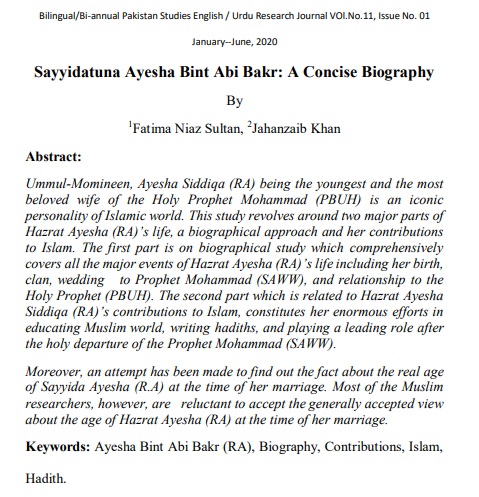Sayyidatuna Ayesha Bint Abi Bakr: A Concise Biography
Keywords:
Ayesha Bint Abi Bakr (RA), Biography, Contributions, Islam, Hadith.Abstract
Ummul-Momineen, Ayesha Siddiqa (RA) being the youngest and the most
beloved wife of the Holy Prophet Mohammad (PBUH) is an iconic
personality of Islamic world. This study revolves around two major parts of
Hazrat Ayesha (RA)’s life, a biographical approach and her contributions
to Islam. The first part is on biographical study which comprehensively
covers all the major events of Hazrat Ayesha (RA)’s life including her birth,
clan, wedding to Prophet Mohammad (SAWW), and relationship to the
Holy Prophet (PBUH). The second part which is related to Hazrat Ayesha
Siddiqa (RA)’s contributions to Islam, constitutes her enormous efforts in
educating Muslim world, writing hadiths, and playing a leading role after
the holy departure of the Prophet Mohammad (SAWW).
Moreover, an attempt has been made to find out the fact about the real age
of Sayyida Ayesha (R.A) at the time of her marriage. Most of the Muslim
researchers, however, are reluctant to accept the generally accepted view
about the age of Hazrat Ayesha (RA) at the time of her marriage.
References
Abbott, N. (1942). Aishah, the Beloved of Muhammad. Chicago, USA:
University of Chicago Press.
Abdelkader, E. (2012). From Aisha bint Abu Bakr to Asmaa Mahfouz: The
Legacy of Muslim Women Roles in Populist Revolutions. The
University of London’s Yearbook on Islamic Law.
Al-Ahzab. Chapter 33: Verse 6.
Al-'Asqalani. I.H. (1412h). Abul Fadhl Shihabuddeen Ahmad ibn Ali alAsqalani. Al-Isaba fi Hayathi Sahaba. Beirut, Lebenon: Dar al-Jil,
vol 4.p 349.
Al- ‘Asqalani, I.H. (15th Century). Tehz’bu’l-tehzib. Dar Ihya al-turath alIslami.
Al-'Asqalani. I.H. (2013). Fath al-Bari bi Sharh Sahih al-Bukhari.
Al-Bukhari, M.I.I. Sahih al-Bukhari: The Translation of the Meanings,
translated by Muhammad M. Khan, Darussalam, 1997, vol. 5, book
, no. 3896; cf. vol. 7, book 67, no. 5158.
Al-Nasa'i. (1997). p. 108.
Al-Tabari. (1979). Tarikhu’l-umam wa’l-mamlu’k. Beirut: Arabic, Dara’lfikr, 4(50).
Al-Tabari, A.J.M.B.J. (1987). The History of al-Tabari, Volume VII, The
Foundation of the Community, M. V. McDonald, translator, State
University of New York Press.
Armstrong, K. (1992). Muhammad: A Biography of the Prophet. San
Francisco: Harper.
Elsadda, H. (2001). Discourses on Women's Biographies and Cultural
Identity: Twentieth Century Representations of the Life of `Aisha
Bint Abi Bakr. Feminist Studies, 27(1), 37-64.
Geldart, A. 2000. Islam. Harcourt Heinemann.
Geissinger, A. (2017). No, a Woman Did Not “Edit the Qurʾān”: Towards
a Methodologically Coherent Approach to a Tradition Portraying a
Woman and Written Quranic Materials. Journal of the American
Academy of Religion, 85(2), 416–445.
Guillaume. (1955). p. 679 and 682.
Ibn Kathir. (n.d). Al-Bidaya wa'l-Nihaya. Retrieved from
http://www.australianislamiclibrary.org/al-bidaya-wannahaya.html.
Ibn Saad, M. (1995). Kitab at-Tabaqat al-Kabir. In A. Bewley (Trans.),
Women of Madina. London: Ta-Ha Publishers.
Ibni Saad. (1996). Wa Mim-Bani Tamimibni Murratabni Ka ‘bin. Beirut,
Lebenon: Darul-Ihya’it-Turathil- ‘Arabi.
Lings, M. (1983). Muhammad: His Life Based on the Earliest Sources.
U.K.: Islamic Texts Society.
Sahih Muslim. (n.d.). Vol. 8, No:3311.
Sahih Muslim. (n.d.). Volume 7, Book 62, Number 74
Spellberg, D.A. (1994). Politics, Gender, and the Islamic Past: The Legacy
of A’isha bint Abi Bakr. New York: Colombia University Press.
Sunan At-Tirmidhi. Kitabul-Manaqib, Babu Fadli ‘A’ishah. Hadith No.
UNICEF. (2011). https://data.unicef.org/topic/child-protection/childmarriage/
UNICEF. (2015). https://data.unicef.org/topic/child-protection/childmarriage/
Thirmudhi, A.I.M.I.I. (1996). Al-Jamiul Kabir. Befirut: Daul Gharib alIslami. 63(3883).
Tirmzi, Abwab AL basar wasala, 1/689



